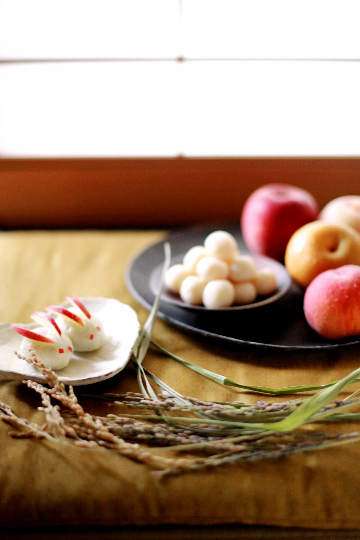
The 15th day of the 8th lunar month is known as the day for Mid-Autumn Festival, and in Japan it is basically the day to appreciate the full (or near-full) moon, and eat some dango or rice dumplings. While the moon itself may or may not make an appearance on this particular day depending on the weather, folks still like to enjoy dango to, well, observe a good old tradition. That's even when it happens to be, as it was this year, another 90F day during the and does not feel like it is autumn, let alone mid autumn, at all. But that's that.)
The day fell on the 22nd of September this year, and the weather forecasts for the evening was rain, unfortunately - but I still went ahead and made some tsukimi dango, or literally "moon-viewing dumplings". I must admit that it's not something I do every year - come to think of it, the last time I made my own dango for the occasion was back in 2004 (!) when I made black sesame dumplings in lime syrup. But I decided to make some anyway.
And as I did so, I played around a bit with the dough and turned some into bunnies.
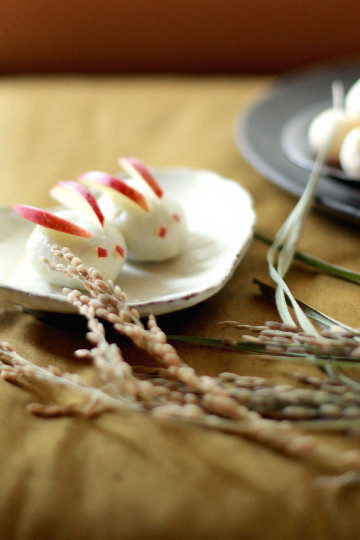
Why bunnies, you might wonder; it's because of this old Japanese myth that says rabbits live on the moon - and they also say that they are making mochi; not the same as dango, strictly speaking, but close enough. Anyhow, that is why you'd often find the moon and rabbit(s) illustrated in Japanese artworks, and though the idea of making dumplings in a shape of rabbit may sound rather creative, it is not at all uncommon, as I've seen quite a few dango bunnies, both hand-made and store-bought (all in Japanese).
My dango bunnies had eyes and ears cut from an apple, and each was filled with a large candied chestnut; apples and chestnuts are both food of autumn, so I thought it would be suitable to use them for a treat to honor the "mid-autumn" moon. Simple enough.
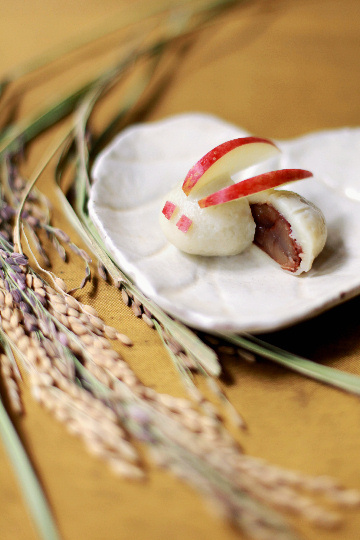
Except, the dumplings ended up tasting a little too simple. Not that they weren't tasty, but I should probably have made a little more effort to better "bridge" the flavors of the ingredients, I think - perhaps by making the filling with sweetened puree of chestnuts (or even Japanese sweet potatoes), chopped candied chestnuts, and slices of apple compote? I don't know, but my excuse this time was that I didn't have time for any of that, and my focus was to make my dumplings in a shape of bunny, which I think I did alright. I know they were rough around the edges, but good enough for me (and my family who are always very generous to me when it comes to my cooking and baking).
Other than bunnies, I also made regular ball-shaped dango, too, which we ate with the sweet and salty mitarashi sauce.
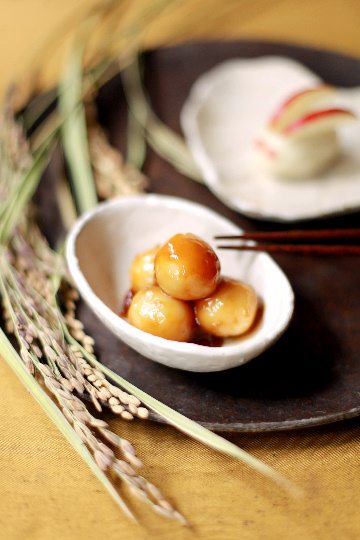
Made from soy sauce and sugar, mitarashi is what I'd think of as "soy sauce caramel". It is one popular sauce for dango, and definitely one of my favorite sauces/toppings/fillings for dango or mochi, along with kinako and sesame seeds. (You know, I don't like anko, or sweet adzuki bean paste, which is an indispensable ingredients in Japanese sweets including dango.)
Mitarashi sauce is fairly simple to make. Like everything else, there are a number of slightly different recipes that involve slightly different sets of ingredients, but you basically combine all the ingredients in a saucepan and cook until the mixture is a bit thick and glossy. I must confess I didn't precisely measure the ingredients (for the lack of measuring spoons around the house), but mine had something like this: 1 Tbs potato starch (cornstarch or arrowroot may be used), scant 1/2 cup (100 ml) water, 2-3 Tbs soy sauce, 2-3 Tbs sugar, 1 Tbs sake. It helps to dissolve the starch first in the water before adding the other ingredients, as the recipe I referred to (in Japanese) tells you.
While you are at it, I should might as well talk a bit about the dumpling dough - and its key ingredient: rice flour. There are several different types of rice flours used to make Japanese mochi and dango, but here I used the type called joshinko, or regular Japanese rice ground to powder. (Other types include shiratama-ko, which is made from glutenous rice [mochi-gome] - they make stickier, softer dumplings.) Some dango recipes call for joshinko, others shiratamako, and yet others a mixture of both (or another types of glutenous rice flour, even). But for tsukimi dango, many recipes seem to use joshinko, for you want your dango to stay nice and round, without collapsing as it may be the case with softer dango made with glutenous rice flour.
But joshinko tends to produce tougher dango. To give the dumplings a softer texture, I used tofu in place of water that is usually used; it's a method often used for shiratamako-based dango, and it worked equally well with joshinko. Normally, you start by combining roughly equal parts of joshinko and boiling water. But here I simply combined 200 g (approx. 7 oz) each of joshinko and tofu ("silken" type, but you can use harder "momen" tofu, too), mixed together until it formed a dough, then kneaded a bit until it was slightly elastic, adding a little more tofu along the way if the dough was too dry (although it is meant to be a slightly dry dough, when you use joshinko). The dough will make some 20-30 small dumplings, depending on how big or small you make them. I had six bunnies and 20 or so small dango. Now joshinko-based dango are often prepared by steaming the dough, but I went for an easier option: boiling. You pop the round pieces of dough into a pot of boiling water, wait until they float up to the surface, and then cook for a further few minutes; transfer them into a bowl of ice water to stop cooking.
Well, I think I'm doing a pretty bad job of describing the procedures, but if you would like to see more detailed, clear instructions for dango, you can turn to more reliable sources such as this and this. (Incidentally, the both sites provide a recipe for mitarashi sauce, too.)
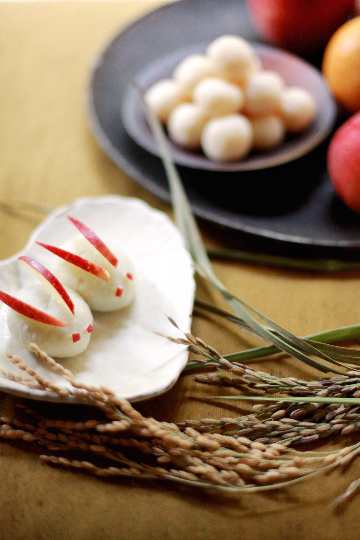
So my tsukimi dango were made, plated carefully, and placed by the window as an offering for the occasion along with seasonal fruits, according to the tradition. By the time they were ready, it started getting dark (hence the poorer-than-normal image quality; apologies!), and soon the moon appeared in the rapidly darkening sky.
Oh yes, the good weather held up into the evening and we did get to see the near-full moon, brightly shining up there. And the evening turned out to be a pleasant, cool one - the autumn finally seemed to have arrived in Tokyo.


6 comments:
I love your bunnies!
I've been wanting to know the differences between the various types of rice flour available in Japan. Thanks for the explanation.
I love these bunnies-so cute!!
How Cute. I didn't know all this about the new moon this month, nice to be informed ;)
Chika san, I love your photos! May I ask what kind of camera and lens you use? Do you use the same lens for your outdoor photos as you do for the food photos?
konnichiha, Chika-san!
greeting from Sendai :)
Your photos are really great and amazingly soothing!
Those bunnies are really cute! Nowadays my son will not eat his meal if it's not attractive. Thanks for giving me an idea.
I'm curious about your lens too. Your photos look so good!
Post a Comment